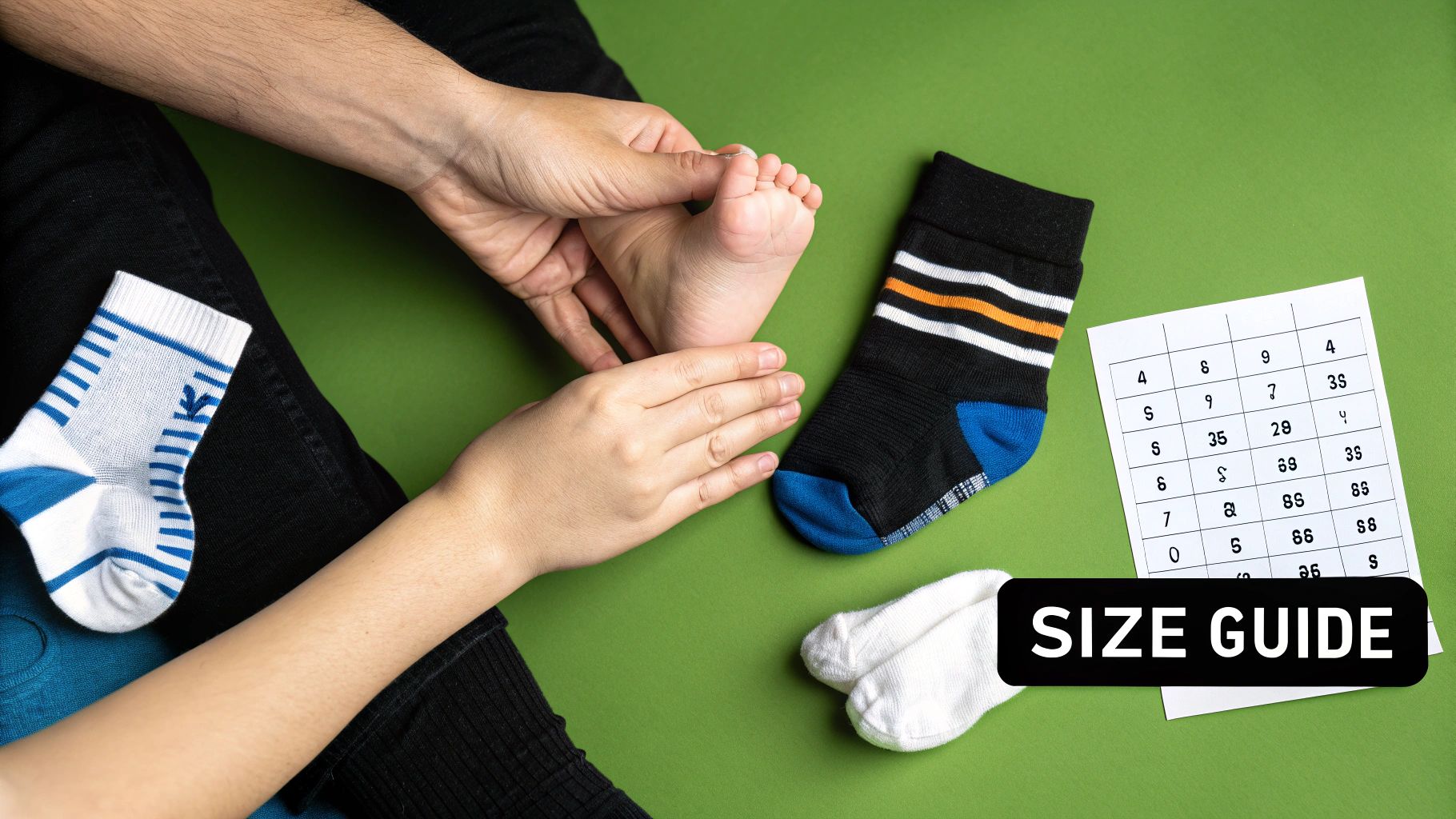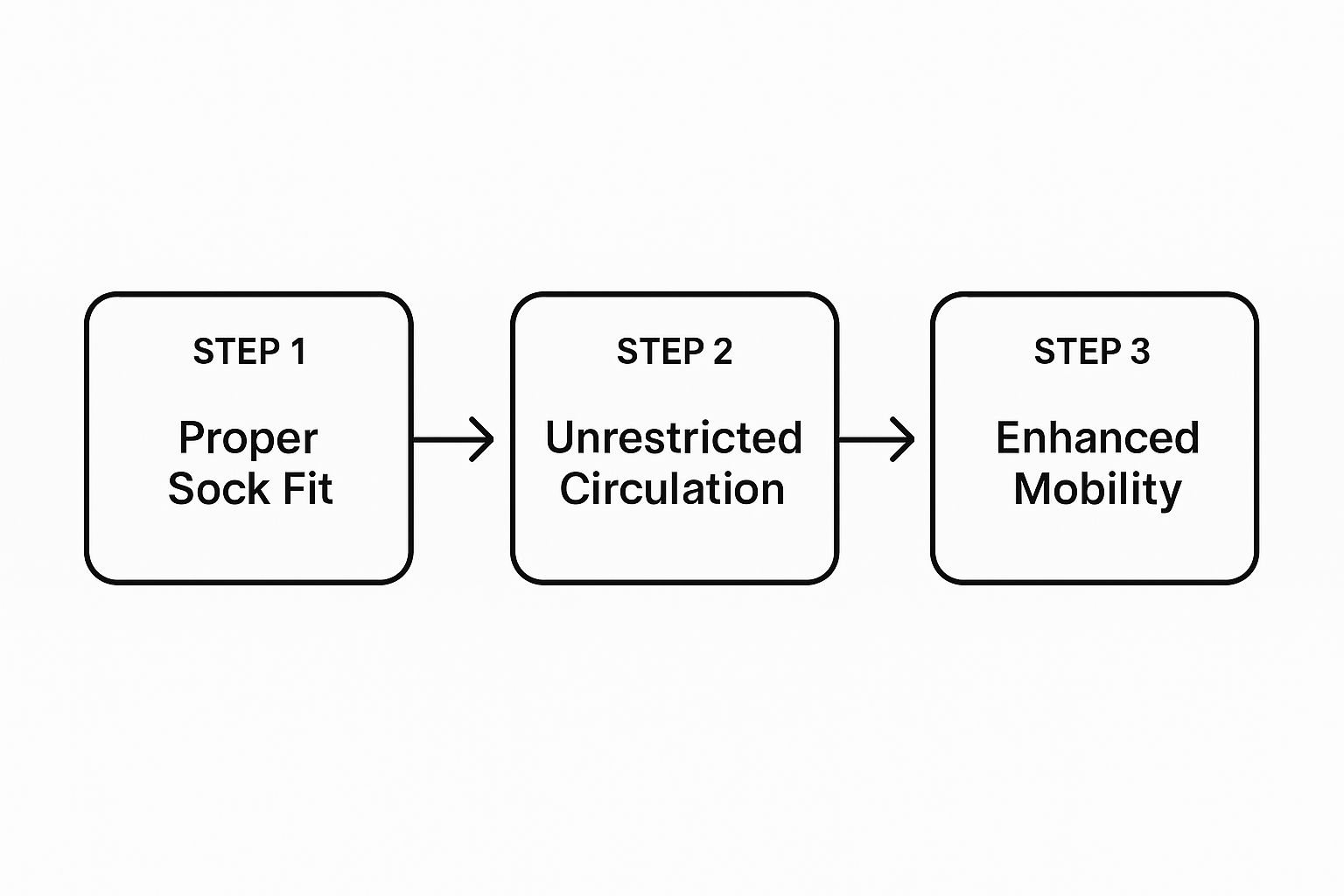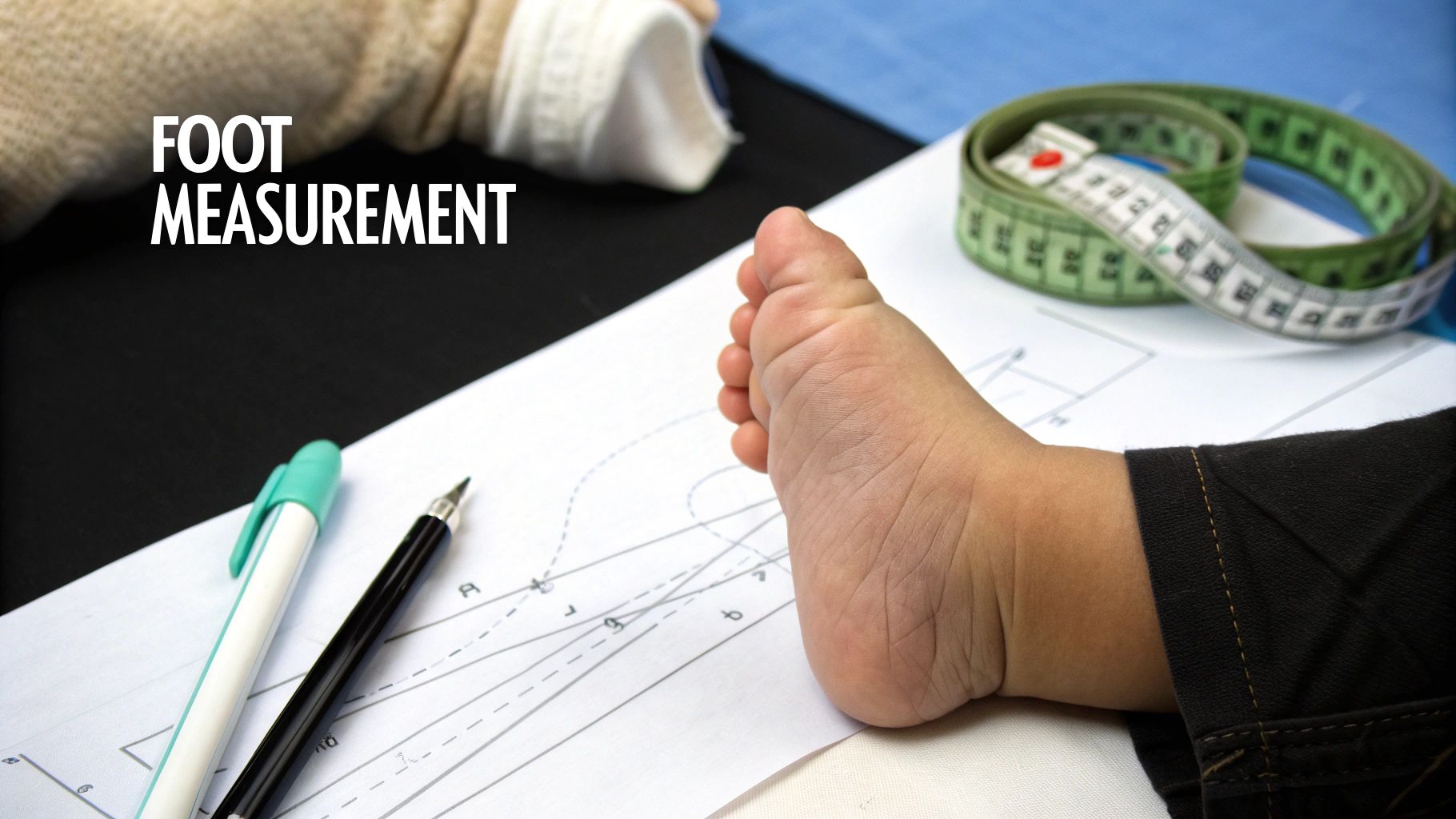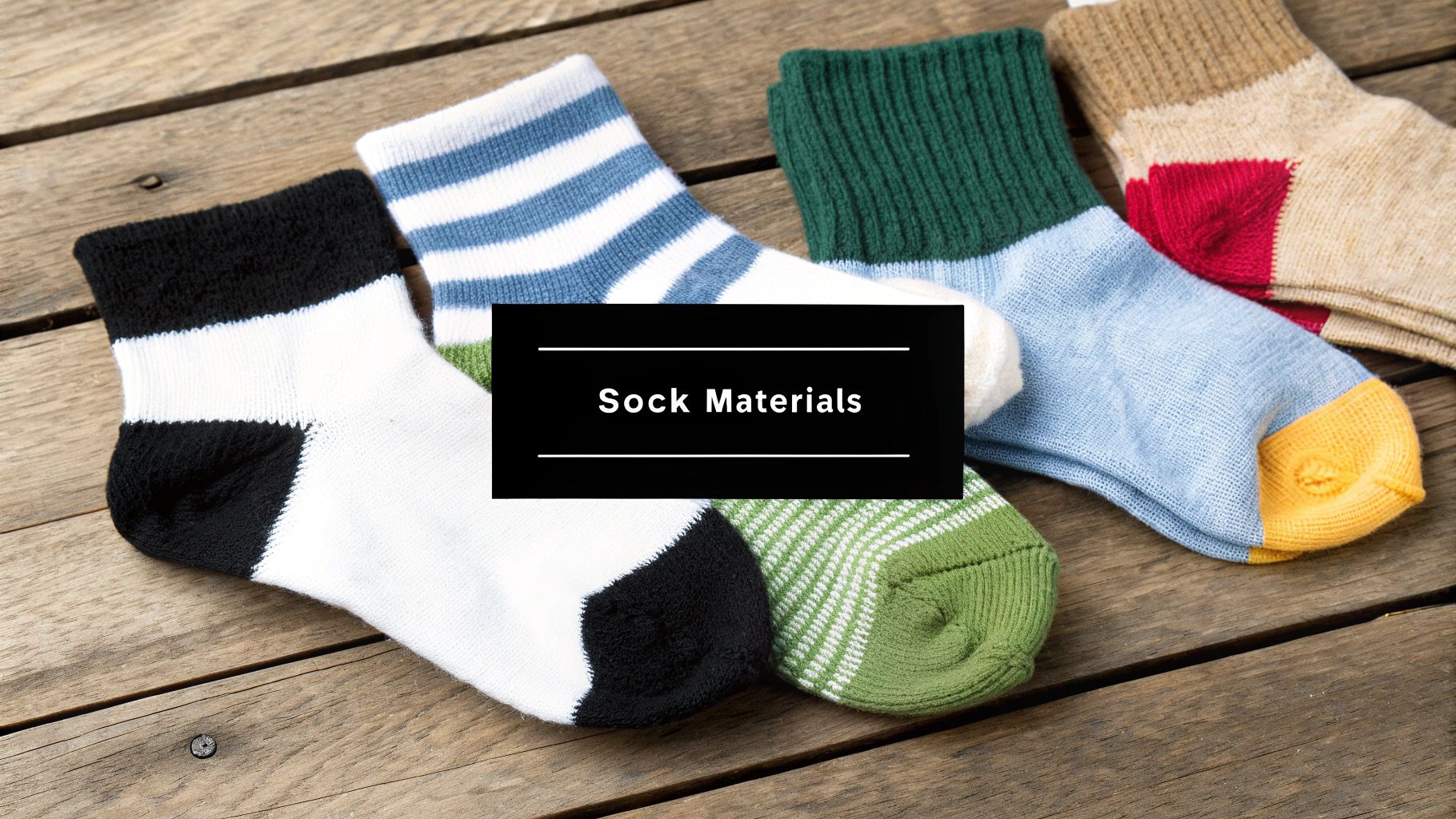Trying to figure out baby sock sizes can feel like a guessing game, but it's actually pretty straightforward once you know what to look for. The two key ingredients are your baby's age and, more importantly, their foot length.
As a starting point, newborns and babies up to 6 months old generally wear sock sizes 0-2.5. This typically covers tiny feet up to 4 inches long. Once they get a bit bigger, from 6-12 months, you'll likely be looking for sizes 2.5-5.5 to fit feet measuring between 4 and 5 inches.
Your Quick Guide to Baby Sock Sizes

A proper fit isn't just about comfort—it's also about safety. A sock that's too loose will constantly slip off (and get lost!), while one that's too tight can be uncomfortable and even restrict those rapidly growing feet.
While age is a great guideline, you've probably noticed that sizing can be all over the place from one brand to the next. That's why the absolute best way to get it right is to measure your baby’s foot. A quick check from their heel to the tip of their big toe gives you the most accurate number to work with.
To make things even easier, here is a quick reference chart to help you find the right size in a flash.
Baby Sock Size Quick Reference Chart
| Age | US Sock Size | Foot Length (Inches) | Foot Length (cm) |
|---|---|---|---|
| 0-6 Months | 0-2.5 | Up to 4" | Up to 10.2 cm |
| 6-12 Months | 2.5-5.5 | 4" - 5" | 10.2 - 12.7 cm |
| 12-24 Months | 5.5-8.5 | 5" - 6" | 12.7 - 15.2 cm |
| 2-4 Years | 8.5-11.5 | 6" - 7" | 15.2 - 17.8 cm |
Use this chart as your go-to guide when you're shopping. It'll help you make sure every pair of socks you buy for your little one is a perfect, comfy fit.
Why the Right Sock Fit Is Crucial for Your Baby
When you're a new parent, it's easy to think of baby socks as just another cute accessory. But getting the right fit is about so much more than keeping those tiny toes warm—it’s a key part of your baby’s healthy development.
Think about it: socks that are too tight can actually restrict circulation and get in the way of natural foot growth. On the flip side, socks that are too loose are a nuisance. They slip off constantly and can even become a safety hazard if your little one trips on them. A snug, proper fit is what you're aiming for. It provides warmth and supports them as they hit big milestones like crawling and eventually taking those first steps.
This simple idea shows just how much the right fit matters.

As you can see, a good fit promotes healthy circulation, which is essential for enhancing their mobility and letting them move freely. It's no wonder the global kids' sock market is valued at a massive USD 2.3 billion; parents everywhere are realizing how important these little details are. If you're interested, you can discover more insights about the kids sock market to see what’s driving the latest trends.
How to Measure Your Baby’s Feet Accurately at Home

Before you can even think about which adorable socks to buy, you need one crucial piece of information: your baby’s accurate foot measurement. Getting this right is the secret to finding that perfect, stay-on-all-day fit.
The easiest and most reliable way to do this at home is with the trace method. Just grab a piece of paper and wait for a calm moment.
The Trace Method: A Step-by-Step Guide
- Step 1: Place your baby’s foot flat on the paper. Try to do this when they're relaxed, maybe after a nap or a feed, to make sure their toes aren't curled up.
- Step 2: With a pen or pencil, make a small mark at the very back of their heel and another at the tip of their longest toe (which isn't always the big toe!).
- Step 3: Now, simply use a ruler or a soft tape measure to find the distance between those two marks. This is the number you need.
It's a little-known fact that most people have one foot that's slightly bigger than the other, and babies are no exception. That’s why you should always measure both feet. When you’re ready to pick a size, use the measurement from the larger foot to guarantee a comfy, non-restrictive fit.
Knowing how to measure is just the first step. For a broader look at how this fits into their whole wardrobe, take a look at our complete parents' guide to understanding children's clothing sizes.
Finding The Right Fit: A Guide To Baby Sock and Shoe Sizes
Trying to figure out which sock size your baby needs can feel like a guessing game. To make it easier, we've put together a detailed chart that maps out typical sizes based on age. It covers everything from tiny Preemie and Newborn sizes all the way up to 24 months.
This chart gives you the corresponding US sock size, the typical US shoe size for that age, and the average foot length in both inches and centimeters. Keep in mind, while age is a great starting point, every baby grows at their own pace. For a truly perfect fit, it's always best to measure your little one's foot directly.
Once you've got the sock situation sorted, the next step is often shoes. You can learn more about how to choose the right footwear for your growing child to keep those tiny feet happy and healthy.
Picking the Right Sock Materials and Styles

Getting the right baby sock sizes is a great start, but the material and style play a huge role in your little one's comfort and safety. Think of it this way: what feels good on their skin and what will help them as they move?
Breathable cotton is the go-to for most parents. It’s soft, gentle, and perfect for everyday wear. For those colder months, a cozy wool blend can make all the difference in keeping tiny toes warm. You'll also find a lot of socks with stretchy materials like elastane mixed in—these are fantastic for getting that snug fit that actually stays on their wiggly feet.
The style of the sock is just as important as the fabric. Once your baby starts pulling up and taking those first steps, non-skid gripper socks are an absolute must. They provide that extra bit of traction to help prevent slips and tumbles on hardwood or tile floors.
As they grow into confident little walkers, you can have more fun with different designs, like the cute options you’ll find in our collection of toddler girl socks. It’s also interesting to see how the demand for high-quality and eco-friendly sock materials is growing worldwide. If you're curious, you can discover more insights about children's sock market trends and see what's popular globally.
Getting the Perfect Sock Fit: A Few Simple Tricks
https://www.youtube.com/embed/95Cogdr70mA
Size charts are a great starting point, but the real test comes down to a few hands-on checks. Once the sock is on, try the "finger test." Just press your thumb gently at the tip of your baby's toes. You're looking for about a thumbnail's width of wiggle room—this gives them space to move and grow.
After your baby has worn the socks for a while, slip them off and take a quick look at their ankles and calves. See any red marks or indentations? That's a clear sign the elastic is digging in too tightly, which can be uncomfortable and even restrict circulation.
It's also worth paying attention to how the socks perform during playtime. A good pair will stay put without slipping down or bunching up around the heel. This kind of functional, stay-on design is a big reason the global socks market is growing so fast, with projections to hit USD 20.49 billion. You can dive deeper into these advancements in sock technology and market trends if you're curious.
Common Sock Sizing Mistakes to Avoid
Finding the right baby sock sizes feels like it should be simple, but it's surprisingly easy to get wrong. I've seen countless parents make a few common mistakes, and thankfully, they're all easy to sidestep.
The biggest pitfall is relying solely on age recommendations. Every baby grows at their own unique pace, so a "0-6 Months" sock might fit one three-month-old perfectly and be too tight on another.
Another classic mistake is stocking up on one size before the baby even arrives. It's so tempting, but you could end up with a dozen pairs of newborn socks that your little one outgrows in just a couple of weeks.
And don't forget about brand differences—they can be huge. A size small from one brand might be completely different from another's. It's a common source of frustration for new parents.
If I can offer one piece of advice, it's this: always measure your baby's foot first. After that, buy just a few pairs at a time and always, always double-check the specific brand's size chart before you click "buy."
Still Have Questions About Baby Sock Sizes?
Figuring out baby sock sizes can feel a little tricky at first. It's totally normal to have a few questions pop up as you're trying to keep those tiny feet cozy and comfortable.
Let's clear up some of the most common things parents ask.
How Often Should I Check My Baby’s Sock Size?
Babies grow astonishingly fast, especially in that first year. I always recommend checking their foot size and how their socks are fitting every 4-6 weeks. A quick check this often ensures their socks never get too snug, which could hinder circulation or just be plain uncomfortable for them.
Do Baby Sock Sizes and Shoe Sizes Match?
Nope, they're on completely different scales. This is a super common point of confusion! A single sock size is made to stretch and fit a range of several shoe sizes. That’s why you can't just guess based on their shoe size—it’s much better to rely on a dedicated baby sock size chart.
Are More Expensive Baby Socks Actually Better?
Not necessarily. While a higher price tag can mean you're getting premium organic materials or fancy non-slip grips, the single most important thing is the fit. You can find perfectly fitting, comfortable socks at any price point. Your main goal should always be finding the right size for your baby’s actual foot measurement.
Article created using Outrank